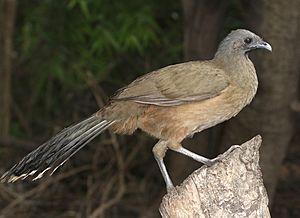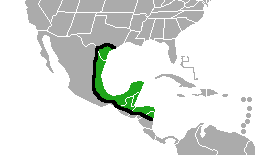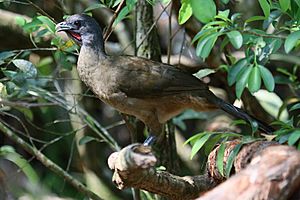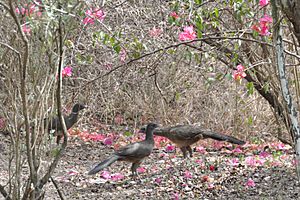Plain chachalaca facts for kids
Quick facts for kids Plain chachalaca |
|
|---|---|
 |
|
| Conservation status | |
| Scientific classification | |
| Genus: |
Ortalis
|
| Species: |
vetula
|
 |
|
| Approximate range (all-year resident) | |
The plain chachalaca (Ortalis vetula) is a medium-sized bird. It belongs to a bird family called Cracidae, which includes chachalacas, guans, and curassows. These birds live in warm, tropical, and subtropical areas.
You can find the plain chachalaca from the southern tip of Texas in the United States, all the way down to northern Costa Rica. They live in places like dry and moist forests, especially where there are also bushes and open grasslands.
These birds usually hang out in groups of up to 15. They are quite shy and careful. If they sense danger, they prefer to run fast on the ground or fly quickly through thick bushes to get away.
Contents
What They Eat
Plain chachalacas find their food both in trees and on the ground. They enjoy eating fruits, like figs and palm fruits, as well as seeds, leaves, and flowers. Sometimes, they might even eat crops like tomatoes and cucumbers, which can make them a bit of a nuisance for farmers.
Sounds and Calls
The plain chachalaca is known for its loud and unique call. It sounds like RAW-pa-haw or cha-cha-LAW-ka. Often, several birds will call together in a rhythmic chorus, especially in the early morning and evening. They usually make these calls from high up in trees.
Besides their main call, they also make soft peeping whistles and cackling sounds. Some people describe their calls as noisy, like a group of people arguing!
Reproduction and Life Cycle
Plain chachalacas typically start breeding when the wet season begins. Their nest is like a shallow dish made of twigs and plant fibers. They line it with leaves and build it in thick plants to keep it hidden.
A female plain chachalaca usually lays 2 to 4 eggs. These eggs have a rough shell and are white to cream in color.
Types of Plain Chachalacas
The plain chachalaca is related to other chachalaca species, like the West Mexican chachalaca and the white-bellied chachalaca. In the past, some thought these were just different types of plain chachalacas. However, experts now agree they are separate species.
There are five recognized types, or subspecies, of the plain chachalaca:
- O. v. deschauenseei – This one is called the Utila chachalaca and lives on Utila Island, near Honduras.
- O. v. mccallii – You can find this type from southern Texas down to northern Veracruz in Mexico.
- O. v. intermedia – This subspecies lives in the southern Yucatán Peninsula, Belize, and Guatemala.
- O. v. pallidiventris – This type is found in the northern Yucatán Peninsula.
- O. v. vetula – This is the main type, found from southern Veracruz in Mexico to northwest Costa Rica.
Even though the population in Costa Rica is considered the main type, some think it might be a new subspecies. Its feathers look more like the plain chachalaca than the white-bellied one.
Appearance
The plain chachalaca is a medium-sized bird, similar in size to a common pheasant. It measures about 48 to 58 centimeters (19 to 23 inches) long. Males are usually a bit heavier than females, but they look very similar.
They have a long neck and a small head. A special feature is a bare patch on their throat. This patch turns a deep red color in both males and females during the breeding season.
Adult plain chachalacas have a grayish head and neck. Their body and wings are a dull olive-brown color. Their belly is pale or yellowish-brown. Their tail is blackish with a green shine and a buffy-white tip. Their eyes are brown, and their beak is black. The skin around their eyes and their feet are dull gray.
Where They Live and Their Home
The plain chachalaca lives in many places. You can find them in Texas, along the eastern coast of Mexico, the Yucatán Peninsula, Belize, northern Guatemala, northern Honduras, and northern Nicaragua. There's also a smaller group on the Nicoya Peninsula in northern Costa Rica.
These birds have also been brought to other places and have settled there. For example, they now live in San Patricio County in Texas and on three islands off the coast of Georgia: Sapelo, Blackbeard, and Little St. Simons Island.
Plain chachalacas can live in many different kinds of homes. These include thick forests, younger forests, forest edges, and areas along rivers. They also live in thorny bush-scrub and shrubland. They can even adapt to places changed by humans, like fruit orchards, suburban parks, gardens, and farmlands. Unlike some other birds in their family, they can live in the bushy areas that grow after tropical rainforests are cleared. They can be found from sea level up to about 1,850 meters (6,070 feet) high.
Daily Life and Conservation
Plain chachalacas are mostly active during the day. They are busiest in the cool mornings and evenings. During the hottest part of the day, they usually rest. Pairs or family groups often sleep together in trees, usually on a branch, sometimes touching each other and facing the same direction.
People sometimes hunt plain chachalacas for food, especially by local communities like the Mayan people in southern Mexico. The total number of plain chachalacas is quite large, estimated to be between 500,000 and 5,000,000 birds in 2006. Because of this, they are not considered an endangered species.
However, one specific type, the O. v. deschauenseei from Útila Island, was once thought to be extinct. But recent studies have shown that it is still alive! In Texas, chachalacas are sometimes considered a game animal, meaning they can be hunted during certain seasons.
Images for kids
See also
 In Spanish: Guacharaca norteña para niños
In Spanish: Guacharaca norteña para niños





